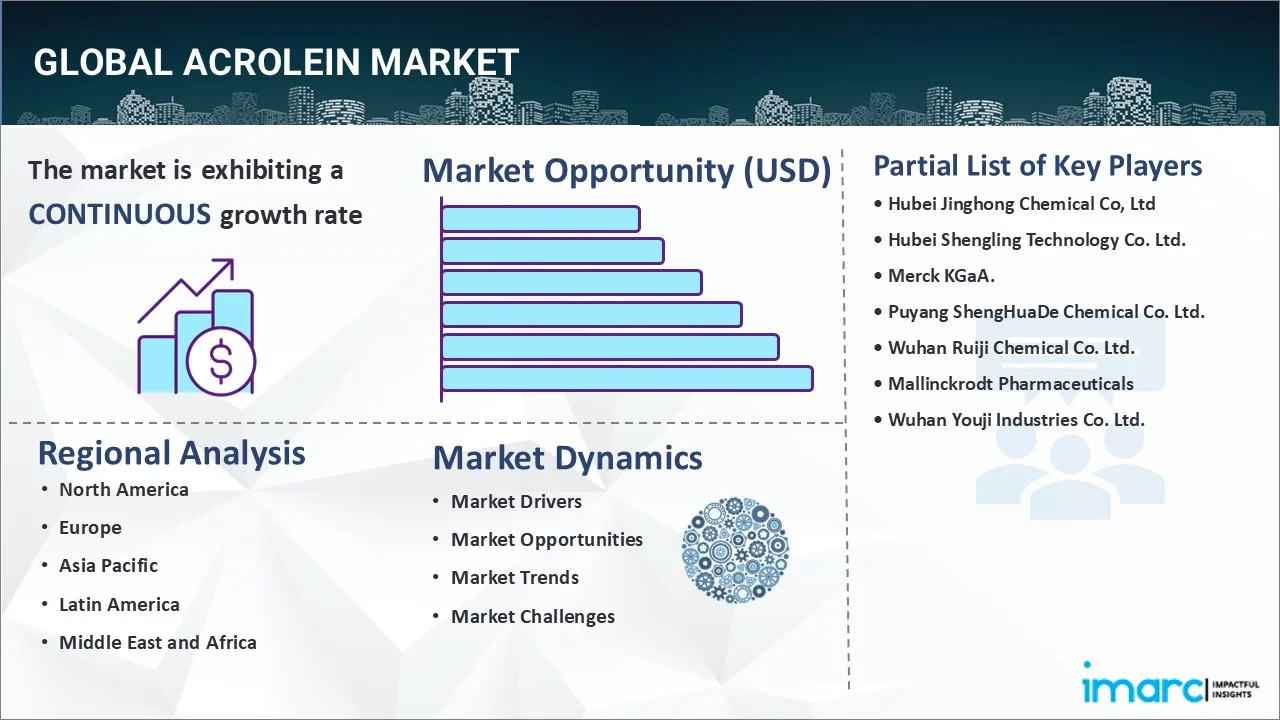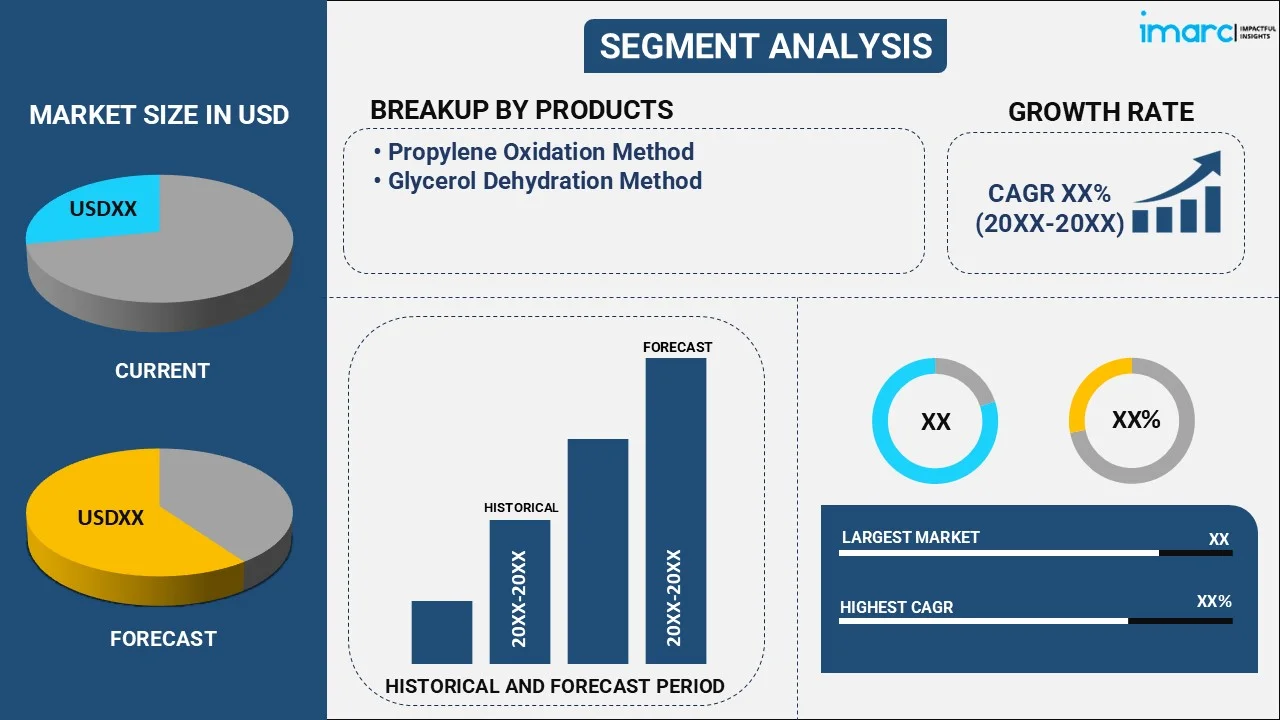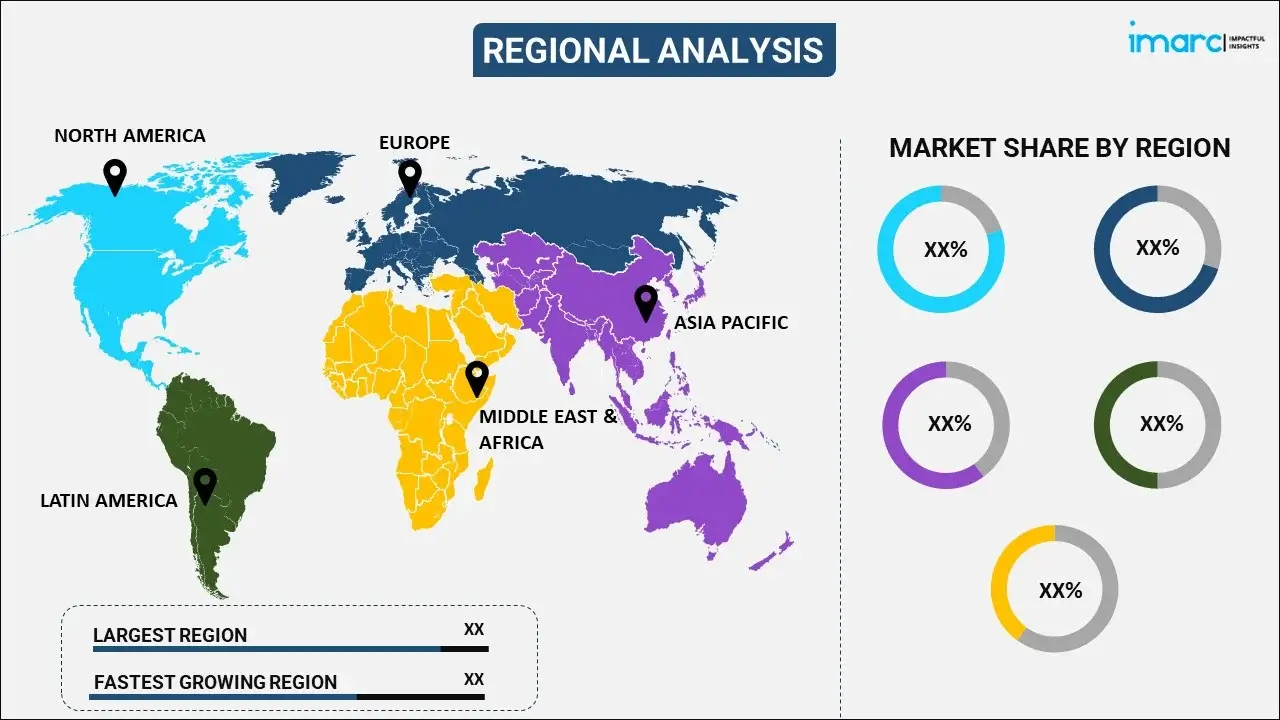
Acrolein Market Report by Product (Propylene Oxidation Method, Glycerol Dehydration Method), Application (Glutaraldehyde, Biocides, Pesticide, Methionine, Water Treatment Agent, and Others), and Region 2025-2033
Market Overview:
The global acrolein market size reached USD 1,178.4 Million in 2024. Looking forward, IMARC Group expects the market to reach USD 1,576.0 Million by 2033, exhibiting a growth rate (CAGR) of 3.28% during 2025-2033. The growing manufacturing of polyester resins and increasing need to produce plastics or colloidal forms of metals are some of the primary factors propelling the market demand. In addition, the rising adoption of acrolein in spinal cord injury and water treatment is opportunistic for the market growth.
|
Report Attribute
|
Key Statistics |
|---|---|
|
Base Year
|
2024 |
|
Forecast Years
|
2025-2033
|
|
Historical Years
|
2019-2024
|
| Market Size in 2024 | USD 1,178.4 Million |
| Market Forecast in 2033 | USD 1,576.0 Million |
| Market Growth Rate (2025-2033) | 3.28% |
Acrolein, also known as propylene aldehyde, is a clear or yellow liquid with a strong and unpleasant odor that is produced by the oxidation of propylene. It is soluble in water, alcohol, ether and acetone and remains stable at the room temperature. It is stored in a cool and dry place and sealed containers that are separated from alkaline materials, such as caustics, ammonia, organic amines, oxygen, strong oxidizers, and mineral acids, to maintain its quality. It is utilized to kill or control microorganisms and bacteria in oil wells and liquid hydrocarbon fuels.

At present, the growing adoption of acrolein in manufacturing polyurethane is influencing the acrolein market outlook positively. In addition, the rising utilization of acrolein as an additive in perfumes is propelling the growth of the market. Apart from this, the increasing employment of acrolein to produce poisonous gas mixtures like tear gas for fighting against enemies in military is strengthening the growth of the market. Moreover, the rising demand for acrolein as a slimicide in manufacturing paper is contributing to the growth of the market. Besides this, the increasing adoption of acrolein as a fixative in histology to preserve biological tissues is supporting the growth of the market. Furthermore, the rising application of acrolein as a test gas for gas masks is bolstering the growth of the market.
Acrolein Market Trends/Drivers:
Growing utilization of acrolein for water treatment stimulating market growth
The acrolein wastewater treatment comprises distillation, acid adjustment, ultraviolet radiation treatment, and biochemical treatment. It is increasingly being utilized for cooling water towers and water treatment ponds around the world, which is propelling the growth of the market. In line with this, the rising employment of acrolein to kill bacteria and microorganisms and control the growth of algae and plants in water treatment plants is contributing to the growth of the market. Apart from this, there is a rise in the need to maintain hygiene and improve the quality of drinking water across the globe. This, coupled with the increasing application of acrolein in irrigation canals and water supplies of industrial plants to reduce floating weeds, is supporting the expansion of the acrolein market size.
Increasing production of acrylic acid catalyzing demand for acrolein
The increasing utilization of acrolein as a chemical intermediate for manufacturing acrylic acid is strengthening the growth of the market. Moreover, acrylic acid polymers are widely utilized for the preparation of emulsifiers, resins, dyes, and nonwoven fabrics across the globe. Besides this, there is a rise in the demand for acrylic acid in adhesive and coating applications. This, coupled with the various benefits offered by acrylic acid like good transparency, stability, adhesion, and flexibility is contributing to the growth of the market. Furthermore, the growing employment of acrylic acid as a super-absorbing agent in diapers and hygienic pads is positively influencing the acrolein market.
Rising adoption of acrolein in offshore oilfield impelling market growth
The rising demand for acrolein to reduce various offshore oilfield problems, such as bacterial growth, is offering a favorable market outlook. Besides this, acrolein is easily soluble in oil and water, which allows removing oil-coated biogenic iron sulfides (FexSy) solids and sessile bacteria from oilfield production systems. In addition, acrolein can provide effective production-odor control and can assist in achieving pipeline specifications of hydrogen sulfide (H2S) and R-SH scavenging. Apart from this, it provides a cost-effective biocide treatment solution due to its low minimum-inhibitory concentration. Furthermore, the increasing utilization of acrolein in offshore environment, as it offers high order of reactivity and biodegradability , is strengthening the growth of the market.
Acrolein Industry Segmentation:
IMARC Group provides an analysis of the key trends in each segment of the global acrolein market report, along with forecasts at the global, regional, and country levels from 2025-2033. Our report has categorized the market based on product and application.
Breakup by Product:

- Propylene Oxidation Method
- Glycerol Dehydration Method
Glycerol dehydration method represents the commonly used product
The report has provided a detailed breakup and analysis of the acrolein market based on the product. This includes propylene oxidation and glycerol dehydration methods. According to the report, glycerol dehydration method represented the largest segment. Glycerol dehydration method can be considered as a green method to produce acrolein, as it is derived from renewable energy sources, such as vegetable oils and animal fats. It is generally performed over an immobilized acidic catalyst.
In the propylene oxidation method, acrolein is produced by oxidizing propylene. In this method, air is used as an oxygen source, whereas metal oxides are used as heterogeneous catalysts Besides this, the rising adoption of the propylene oxidation method to produce acrylic acid is strengthening the growth of the market. Moreover, the growing utilization of propylene oxidation method for manufacturing plastics is propelling the growth of the market. Furthermore, technological advancements in propylene oxidation method, such as the development of catalysts and utilization of renewable energy sources to reduce environmental pollution and lower production costs, is contributing to the growth of the market.
Breakup by Application:
- Glutaraldehyde
- Biocides
- Pesticide
- Methionine
- Water Treatment Agent
- Others
Water treatment agent accounts for the majority of the market share
A detailed breakup and analysis of the acrolein market based on the application has also been provided in the report. This includes glutaraldehyde, biocides, pesticide, methionine, water treatment agent, and others. According to the report, water treatment agent accounted for the largest market share. Acrolein is widely utilized as a water treatment agent to reduce the number of unwanted germs in the water. In addition, the increasing utilization of acrolein in water treatment systems to prevent various diseases among individuals is propelling the growth of the market.
Glutaraldehyde is a transparent oily liquid that is manufactured by the Diels-Alder reaction of acrolein and vinyl ethers, followed by hydrolysis. It is widely utilized for sterilization and disinfection of surgical instruments. Moreover, the rising demand for glutaraldehyde in tissue fixation for electron microscopy is impelling the growth of the market. The increasing popularity of glutaraldehyde as a preservative in cosmetics products is also bolstering the market growth.
Acrolein is a cost-effective biocide that has superior bacterial control properties as compared to other biocides. It prevents fungi, mollusks, and rodents is contributing to the growth of the segment.
Furthermore, acrolein is widely utilized to manufacture pesticides for reducing the growth of germs. The rising utilization of acrolein as a pesticide in the agriculture industry to avoid deterioration of crop yields is strengthening the growth of the market.
Breakup by Region:

- North America
- United States
- Canada
- Europe
- Germany
- France
- United Kingdom
- Italy
- Spain
- Others
- Asia Pacific
- China
- Japan
- India
- South Korea
- Australia
- Indonesia
- Others
- Latin America
- Brazil
- Mexico
- Others
- Middle East and Africa
North America exhibits a clear dominance, accounting for the largest acrolein market share
The report has also provided a comprehensive analysis of all the major regional markets, which include North America (the United States and Canada); Europe (Germany, France, the United Kingdom, Italy, Spain, and others); Asia Pacific (China, Japan, India, South Korea, Australia, Indonesia, and others); Latin America (Brazil, Mexico, and others); and the Middle East and Africa.
North America held the biggest market share due to the increasing demand for acrolein to produce engineering plastic. Apart from this, it is used in personal care products, such as deodorants and hair sprays . This, coupled with the increasing awareness about personal hygiene and grooming among individuals, is contributing to the growth of the market. Furthermore, the rising utilization of acrolein in the manufacturing of several chemicals is bolstering the growth of the market in the region.
Asia Pacific is estimated to expand further during the forecast period, owing to the growing utilization of acrolein in the agrochemical industry, rising adoption of acrolein as a fumigant to disinfect a place, and increasing demand for acrylic acid.
Competitive Landscape:
Key players in the acrolein market are introducing a new acrylic acid reactor that has high capacity and can be utilized in paints and coatings and oil and gas industries. In addition, it can produce a large amount of acrylic acid. Apart from this, manufacturers are focusing on producing sustainable chemical compounds that assist in reducing the environmental pollution. This, coupled with the production of acrolein by utilizing biobased glycerol, is offering lucrative growth opportunities to industry investors. Furthermore, manufacturers are using new catalysts, such zeolite, mixed metal oxides, phosphate catalysts, and heteropoly acids, to produce acrolein in a sustainable manner, which is supporting the growth of the market.
The report has provided a comprehensive analysis of the competitive landscape in the global acrolein market. Detailed profiles of all major companies have also been provided. Some of the key players in the market include:
- Hubei Jinghong Chemical Co, Ltd
- Hubei Shengling Technology Co. Ltd.
- Merck KGaA.
- Puyang ShengHuaDe Chemical Co. Ltd.
- Wuhan Ruiji Chemical Co. Ltd.
- Mallinckrodt Pharmaceuticals
- Wuhan Youji Industries Co. Ltd.
Recent Developments:
- In 2018, Hubei Shengling Technology Co., Ltd. joined the 2018 Chemspec, an exhibition held in India to highlight the strength of the chemical industry.
- In 2020, Merk KGaA, a leading science and technology company, announced collaboration with Foundation Medicine Inc. in Darmstadt, Germany to develop companion diagnostics for selected marketed and pipeline treatments.
- In June 2023, Mallinckrodt Pharmaceuticals, announced the presentation of results from two clinical studies in adults with hepatorenal syndrome (HRS) with rapid reduction in kidney function1 treated with TERLIVAZ® (terlipressin).
Acrolein Market Report Scope:
| Report Features | Details |
|---|---|
| Base Year of the Analysis | 2024 |
| Historical Period | 2019-2024 |
| Forecast Period | 2025-2033 |
| Units | Million USD |
| Scope of the Report | Exploration of Historical and Forecast Trends, Industry Catalysts and Challenges, Segment-Wise Historical and Predictive Market Assessment:
|
| Products Covered | Propylene Oxidation Method, Glycerol Dehydration Method |
| Applications Covered | Glutaraldehyde, Biocides, Pesticide, Methionine, Water Treatment Agent, Others |
| Regions Covered | Asia Pacific, Europe, North America, Latin America, Middle East and Africa |
| Countries Covered | United States, Canada, Germany, France, United Kingdom, Italy, Spain, China, Japan, India, South Korea, Australia, Indonesia, Brazil, Mexico |
| Companies Covered | Hubei Jinghong Chemical Co, Ltd, Hubei Shengling Technology Co. Ltd., Merck KGaA., Puyang ShengHuaDe Chemical Co. Ltd., Wuhan Ruiji Chemical Co. Ltd., Mallinckrodt Pharmaceuticals, Wuhan Youji Industries Co. Ltd., etc. |
| Customization Scope | 10% Free Customization |
| Post-Sale Analyst Support | 10-12 Weeks |
| Delivery Format | PDF and Excel through Email (We can also provide the editable version of the report in PPT/Word format on special request) |
Key Questions Answered in This Report:
- How has the global acrolein market performed so far, and how will it perform in the coming years?
- What are the drivers, restraints, and opportunities in the global acrolein market?
- What is the impact of each driver, restraint, and opportunity on the global acrolein market?
- What are the key regional markets?
- Which countries represent the most attractive acrolein market?
- What is the breakup of the market based on the product?
- Which is the most attractive product in the acrolein market?
- What is the breakup of the market based on the application?
- Which is the most attractive application in the acrolein market?
- What is the competitive structure of the global acrolein market?
- Who are the key players/companies in the global acrolein market?
Key Benefits for Stakeholders
- IMARC’s report offers a comprehensive quantitative analysis of various market segments, historical and current market trends, market forecasts, and dynamics of the acrolein market from 2019-2033.
- The research study provides the latest information on the market drivers, challenges, and opportunities in the global acrolein market.
- The study maps the leading, as well as the fastest-growing, regional markets. It further enables stakeholders to identify the key country-level markets within each region.
- Porter's five forces analysis assist stakeholders in assessing the impact of new entrants, competitive rivalry, supplier power, buyer power, and the threat of substitution. It helps stakeholders to analyze the level of competition within the acrolein industry and its attractiveness.
- Competitive landscape allows stakeholders to understand their competitive environment and provides an insight into the current positions of key players in the market.
Need more help?
- Speak to our experienced analysts for insights on the current market scenarios.
- Include additional segments and countries to customize the report as per your requirement.
- Gain an unparalleled competitive advantage in your domain by understanding how to utilize the report and positively impacting your operations and revenue.
- For further assistance, please connect with our analysts.
 Request Customization
Request Customization
 Speak to an Analyst
Speak to an Analyst
 Request Brochure
Request Brochure
 Inquire Before Buying
Inquire Before Buying




.webp)




.webp)












